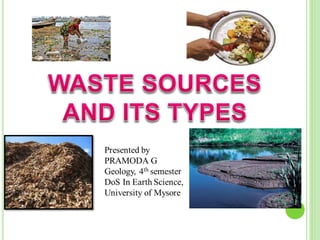
Waste sources and types
- 2. CONTENT Introduction Waste:defenition Waste generation Industrial waste Municipal waste Medical waste Agricultural waste Radioactive waste Hazardous waste E-waste Conclusion Reference
- 3. TYPES OF WASTES Industrial waste Agricultural waste Medical waste Hazardous waste Radioactive waste
- 5. WHAT IS WASTE??????? Waste and wastes are unwanted or unusable materials. Waste is any substance which is discarded after primary use, or it is worthless, defective and of no use.
- 6. HOW WASTE IS GENERATE??? Wastes are generated from variety of sources viz , household ,commercial establishments, industrial processes, agricultural practices and from others. Waste is generated in small , medium and large cities and towns are about 0.1kg,0.3- 0.4kg,and0.5kg per day respectively.
- 7. INDUSTRIAL WASTE Industrial waste is the waste produced by industrial activity which includes any material that is rendered useless during a manufacturing process such as that of factories, mills, and mining operations It has existed since the start of the Industrial Revolution. Some examples of industrial wastes are chemical solvents, paints, sandpaper, paper products, industrial by-products, metals, and radioactive wastes
- 8. Toxic waste, chemical waste, industrial solid waste and municipal solid waste are designations of industrial wastes. Sewage treatment plants can treat some industrial wastes, i.e. those consisting of conventional pollutants such as biochemical oxygen demand (BOD). Industrial wastes containing toxic pollutants require specialized treatment systems.
- 9. INDUSTRIAL WASTE INCLUDES: Manufacturing Mining Coal combustion Oil and gas production
- 10. MINNING Like the majority of human activities, mining operations produce waste materials. “Waste” is a general term for material which currently has little or no economic value. The soil and rock which is removed to gain access to buried ore, and the material (water, solids, and gases) left behind after the ore has been processed to remove the valuable commodities, are considered to be waste materials.
- 11. However, the difference in mineral content between ore and waste rock can change depending on market conditions and available extraction technology, and there are a number of cases where material that was once considered waste has become a resource for modern mining operations.
- 12. COAL COMBUSTION Combustion is a rapid chemical reaction between fuel and oxygen. When combustible elements of fuel combine with O2, heat energy comes out. During combustion combustible elements like Carbon, Sulfur, Hydrogen etc combine with oxygen and produce respective oxides. The source of oxygen in fuel combustion is air. By volume there is 21 % of Oxygen presents in air and by weight it is 23.2 %.
- 13. Although there is 79 % (by volume) nitrogen in air but it plays no role in combustion. Actually Nitrogen carries heat produced during combustion to steam boiler stack. As per combustion theory the quantity of air required for combustion is that which provides sufficient O2 to completely oxidize combustible elements of fuel. This quantity of air is normally known as STOICHIOMETRIC AIR requirement. This amount of air depends upon the nature of fuel.
- 14. OIL AND GAS PRODUCTION Production is the operation that brings hydrocarbons to the surface and prepares them for processing. Production begins after the well is drilled. The mixture of oil, gas and water from the well is separated on the surface. The water is disposed of and the oil and gas are treated, measured, and tested. Production operations include bringing the oil and gas to the surface, maintaining production, and purifying, measuring, and testing.
- 15. The petroleum industry include the global processes of exploration, extraction, refining, transporting (often by oil tankers and pipelines), and marketing petroleum products. The largest volume products of the industry are fuel oil and gasoline (petrol). Petroleum (oil) is also the raw material for many chemical products, including pharmaceuticals, solvents, fertilizers, pesticides, and plastics. The industry is usually divided into three major components: upstream, midstream and downstream
- 17. MUNICIPAL WASTE MSW is defined as any waste generated by household, commercial and/or institutional activities and is not hazardous Municipal solid waste (MSW), commonly known as trash or garbage in the U.S. and as refuse or rubbish in the UK, is a waste type consisting of everyday items that are discarded by the public. “ Garbage" can also refer specifically to food waste, as in a garbagedisposal; the two are sometimes collected separately.
- 18. Depending upon the source, MSW is categorized into three types A. Residential or household waste which arises from domestic areas from individual houses; B. commercial wastes and/or institutional wastes which arise from individually larger sources of MSW like hotels, office buildings, schools, etc.; municipal services wastes which arise from area sources like streets, parks, etc. MSW usually contains food wastes, paper, cardboard, plastics, textiles, glass, metals, wood, street sweepings, landscape and tree trimmings, general wastes from parks, beaches, and other recreational areas . Sometimes other household wastes like batteries and consumer electronics also get mixed up with MSW
- 24. HAZARDOUS WASTE A material is a HAZARDOUS WASTE if due to its quantity, concentration, physical, chemical or infectious characteristics it possesses a substantial present,or potential hazard to human health and environment and has no use
- 26. RADIOACTIVE WASTE Radioactive waste is any material that is either radioactive itself or is contaminated by radioactivity, for which no further use is envisaged. Government policy means that certain nuclear materials such as uranium, plutonium and spent nuclear fuel have not been declared as wastes by their owners.
- 30. CONCLUSION A continuing rise in the rate of waste production is no longer acceptable – hazardous waste affects the health of millions of people and poisons large areas of our planet. In many places people live surrounded by garbage and landfills. It is essential that governments and corporations face up to waste, using what we know about reduction, recycling and reuse, but also developing new technologies that eliminate waste.
- 33. REFERWNCES Environmental science: Dr.S.C Santra Environmemtal management:Kahn D and Grass .D www.Google.com
